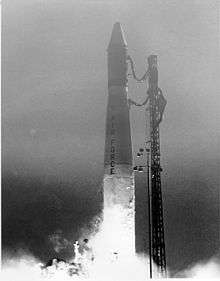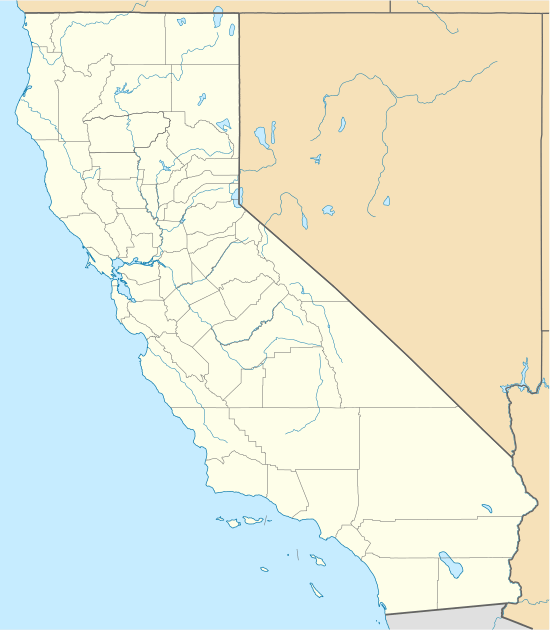Vandenberg Space Launch Complex 10
Space Launch Complex 10, or Missile Launch Complex 10,[3] is located on Vandenberg Air Force Base in Lompoc, California. It was built in 1958 to test ballistic missiles and developed into a space launching facility in 1963.[4] Prior to 1966 Space Launch Complex 10 West was known as Vandenberg AFB Pad 75-2-6.[5] It remains a rare pristine look at the electronics and facilities created in that era that helped the United States grow its space capabilities.
 A Thor DSV-2U carrying a DMSP weather satellite launches from SLC-10W in 1980. This was the last orbital launch from the complex. | |||||||||||||||||||||||||
| Launch site | Vandenberg AFB | ||||||||||||||||||||||||
|---|---|---|---|---|---|---|---|---|---|---|---|---|---|---|---|---|---|---|---|---|---|---|---|---|---|
| Location | 34°45'55"N 120°37'20"W | ||||||||||||||||||||||||
| Short name | SLC-10 | ||||||||||||||||||||||||
| Operator | US Air Force Royal Air Force | ||||||||||||||||||||||||
| Total launches | 38 | ||||||||||||||||||||||||
| Launch pad(s) | 2 | ||||||||||||||||||||||||
| Orbital inclination range | 51° – 145° | ||||||||||||||||||||||||
| |||||||||||||||||||||||||
Space Launch Complex 10 | |||||||||||||||||||||||||
  | |||||||||||||||||||||||||
| Location | Vandenberg Air Force Base, Lompoc, California | ||||||||||||||||||||||||
| Coordinates | 34°45′55″N 120°37′20″W | ||||||||||||||||||||||||
| Architect | United States Air Force | ||||||||||||||||||||||||
| NRHP reference No. | 86003511[1] | ||||||||||||||||||||||||
| Significant dates | |||||||||||||||||||||||||
| Added to NRHP | June 23, 1986 | ||||||||||||||||||||||||
| Designated NHL | June 23, 1986[2] | ||||||||||||||||||||||||
The last launch from this complex was a Thor booster in 1980.[3] It was declared a National Historic Landmark in 1986.[2][3]
It is undergoing an eight-year restoration, and public visits are possible, if arranged in advance.[6]
History
The launch complex was built in 1958 by the Douglas Aircraft Corporation, and was first designated Complex 75-2. At that time it consisted of three launch pads, which were used to train military operators of PGM-17 Thor ballistic missiles, and to conduct missile launch tests. The first launches were conducted by the British Royal Air Force in June and August 1959.[3] The facilities at SLC-10 were dismantled and transported to Johnston Island in support of Operation Dominic, a nuclear weapons testing project conducted there in 1962.
The launch complex was rebuilt in 1963 to support the development of Burner rockets, with two launch pads, designated SLC-10E and SLC-10W. Tests were conducted at SLC-10W from 1965 to 1980, using the Thor satellite launch vehicles, the first stages of which followed the design of the Thor missile.
Surviving elements
Two launch pads and a prefabricated launch blockhouse are the principal surviving elements of the complex. The blockhouse interior still includes all of the electrical equipment used in later launches. SLC-10W also includes pipes and storage facilities for storing and managing the liquid fuel used in the rockets.[7]
References
- "National Register Information System". National Register of Historic Places. National Park Service. April 15, 2008.
- "Space Launch Complex 10". National Historic Landmark summary listing. National Park Service. Archived from the original on 2007-11-14. Retrieved 2007-11-18.
- Captain Mark C. Mondl (January 3, 1986). "National Register of Historic Places Inventory-Nomination: Space Launch Complex 10 / Missile Launch Complex 10" (pdf). National Park Service. Cite journal requires
|journal=(help) and Accompanying 5 photos, exterior and interior, undated. (601 KB) - DOD NHL details for California
- Ed Kyle (3 July 2009). "Thor Burner - Sixth in a Series Reviewing Thor Family History".
- NPS History of Aviation
- "Space Launch Complex 10". National Park Service. Retrieved 2018-02-13.
